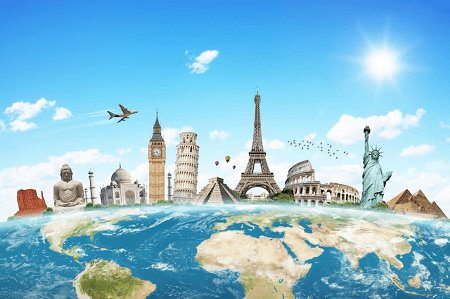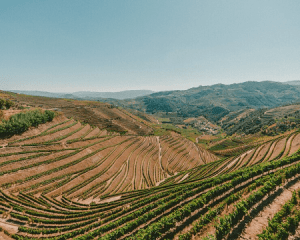TOURISM-
There are several types of tourism, each catering to different interests, motivations, and experiences of travelers. Here are some common types of tourism:
- Cultural Tourism: Involves visiting historical sites, museums, festivals, and experiencing the local traditions and lifestyles of a place.
- Ecotourism: Focuses on responsible travel to natural areas, conserving the environment, and improving the well-being of local people.
- Adventure Tourism: Includes activities such as hiking, trekking, mountaineering, rafting, and other outdoor pursuits that involve physical exertion and exploration of remote areas.
- Medical Tourism: Involves traveling to another country to receive medical treatment or procedures, often combining it with leisure and recuperation.
- Beach Tourism: Revolves around visiting coastal areas for relaxation, water sports, and enjoying the beach lifestyle.
- Wildlife Tourism: Involves observing and experiencing wildlife in their natural habitats through safaris, bird-watching tours, and visits to national parks and reserves.
- Culinary Tourism: Focuses on experiencing local food and beverages, including cooking classes, food festivals, and visits to markets and restaurants known for their regional cuisine.
- Urban Tourism: Involves visiting cities to explore their cultural attractions, architecture, shopping districts, dining scenes, and entertainment options.
- Rural Tourism: Offers experiences in rural areas, focusing on agriculture, local traditions, rural crafts, and outdoor activities like farm stays and agritourism.
- Luxury Tourism: Targets affluent travelers seeking high-end accommodations, fine dining, exclusive experiences, and personalized services.
These types of tourism can overlap and blend together depending on the destination and traveler preferences, contributing to diverse and enriching travel experiences worldwide.
What is Required TOURISM
“Required tourism” isn’t a commonly recognized term in the tourism industry. However, if we interpret it broadly, it could imply the essential components or factors necessary for tourism to thrive or be successful. Here are some aspects that could be considered essential or required for tourism:
- Infrastructure: Adequate transportation (airports, roads, public transit), accommodation (hotels, resorts, guesthouses), and other facilities (restaurants, attractions, amenities) are essential for accommodating tourists.
- Safety and Security: Ensuring the safety and security of tourists through effective measures and protocols is crucial to building trust and encouraging travel.
- Cultural and Natural Resources: Preserving and showcasing cultural heritage sites, historical landmarks, natural landscapes, and biodiversity are fundamental in attracting tourists interested in cultural and eco-friendly experiences.
- Marketing and Promotion: Effective marketing strategies and promotion of destinations through various channels (online platforms, travel agencies, tourism boards) are necessary to attract tourists and create awareness.
- Regulations and Policies: Clear regulations and policies governing tourism activities, including visa requirements, environmental sustainability guidelines, and visitor management strategies, help ensure sustainable tourism development.
- Community Engagement: Involving local communities in tourism planning, development, and benefits sharing fosters positive relationships and sustainable tourism practices.
- Tourism Services and Experiences: Offering diverse and high-quality tourism services and experiences (guided tours, adventure activities, cultural events, culinary experiences) tailored to different traveler preferences and interests.
- Accessibility: Ensuring ease of access to tourism destinations through transportation networks and infrastructure that cater to different types of travelers (solo, family, elderly, disabled).
- Environmental Conservation: Promoting responsible tourism practices that minimize environmental impact, conserve natural resources, and protect fragile ecosystems.
- Economic Benefits: Tourism should contribute positively to local economies by generating employment opportunities, income for local businesses, and promoting sustainable economic growth.
Overall, these components collectively form the necessary framework for successful and sustainable tourism development in any destination.
Who is Required TOURISM
It seems there might be a misunderstanding or confusion regarding the term “Required Tourism.” If you are referring to a specific person or entity named “Required Tourism,” it does not correspond to any known individual or organization in the tourism industry.
If you meant to ask about key stakeholders or entities involved in the tourism industry, they typically include:
- Tourists: Individuals or groups who travel for leisure, business, or other purposes.
- Tourism Providers: Businesses and organizations that offer services and products to tourists, such as hotels, restaurants, tour operators, airlines, and transportation services.
- Destination Management Organizations (DMOs): These are entities responsible for promoting and managing tourism in specific destinations, such as tourism boards, local governments, and tourism associations.
- Government Authorities: Local, regional, and national government bodies that regulate tourism, establish policies, provide infrastructure, and ensure safety and security for tourists.
- Local Communities: Residents of tourism destinations who may be directly or indirectly involved in tourism activities, including cultural performances, artisanal crafts, and providing homestay accommodations.
- Non-Governmental Organizations (NGOs): Organizations that work on environmental conservation, sustainable tourism practices, and community development related to tourism.
- Academic and Research Institutions: They conduct research, provide education, and offer insights into tourism trends, impacts, and sustainable development practices.
These stakeholders work together to ensure the sustainability, growth, and positive impact of tourism on destinations and communities worldwide.
When is Required TOURISM
If by “Required Tourism” you mean the timing or period when tourism is necessary or essential, it typically depends on various factors such as:
- Seasonality: Many destinations have peak seasons when tourism is particularly vital for their economy and infrastructure. For example, coastal areas may rely on tourism during the summer months, while ski resorts thrive in winter.
- Events and Festivals: Certain events, festivals, or cultural celebrations can attract tourists during specific times of the year. Examples include music festivals, religious holidays, or local traditions.
- Economic Factors: Tourism might be crucial during economic downturns or recessions as it can provide a boost to local businesses and employment.
- Government Policies: Policies and initiatives promoting tourism, such as marketing campaigns or incentives, can influence when tourism is deemed necessary or encouraged.
- Infrastructure Development: Times when new infrastructure or attractions are completed can coincide with efforts to attract tourists to visit.
Ultimately, the timing of when tourism is considered required or beneficial varies widely depending on the specific context of the destination and its tourism industry. Each location may have its own peak seasons or periods when tourism plays a critical role in its economic and social fabric.
Where is Required TOURISM

“Required Tourism” doesn’t refer to a specific location or destination. Instead, tourism is a global phenomenon that occurs in various places around the world where people travel for leisure, business, education, or other purposes.
Tourism can take place in:
- Countries and Regions: Tourists visit different countries and regions to explore their cultural heritage, natural attractions, historical sites, and modern amenities.
- Cities and Urban Areas: Urban tourism focuses on cities that offer diverse cultural experiences, entertainment, shopping, dining, and historical landmarks.
- Rural and Natural Areas: Many tourists seek experiences in rural or natural environments such as national parks, countryside retreats, and eco-friendly lodges.
- Coastal and Beach Destinations: Coastal tourism attracts visitors to beaches, resorts, and coastal towns for relaxation, water sports, and marine activities.
- Mountainous and Adventure Destinations: Adventure tourism takes place in mountainous regions, offering activities such as hiking, skiing, mountaineering, and wildlife viewing.
- Cultural and Heritage Sites: Tourists also visit cultural and heritage sites worldwide, including museums, art galleries, religious sites, and architectural wonders.
- Specialized Destinations: These include places known for specific types of tourism like medical tourism (hospitals and wellness centers), culinary tourism (food and wine regions), and educational tourism (universities and educational institutions).
In essence, tourism occurs wherever there are attractions, amenities, and services that cater to visitors’ interests and needs. It’s a diverse and dynamic industry that spans across the globe, contributing significantly to economies and cultural exchange worldwide.
How is Required TOURISM
If we interpret “Required Tourism” as how tourism is necessary or essential, we can explore the ways in which tourism contributes to various aspects of society and the economy:
- Economic Impact: Tourism is a significant economic driver in many regions, contributing to employment, income generation, and business opportunities. It stimulates growth in sectors such as hospitality, transportation, entertainment, and retail.
- Infrastructure Development: The demand from tourists often drives infrastructure development, including transportation networks (airports, roads, public transit), accommodations (hotels, resorts), and recreational facilities (parks, attractions).
- Cultural Exchange: Tourism fosters cultural exchange and understanding between people from different regions and backgrounds. Visitors experience local traditions, cuisine, arts, and customs, while locals have opportunities to interact with visitors from around the world.
- Preservation of Heritage: Tourism can contribute to the preservation and conservation of cultural and natural heritage sites. Revenue generated from tourism often funds the maintenance and restoration of historical landmarks and environmental conservation efforts.
- Diversification of Income: For many communities, tourism provides an alternative or additional source of income beyond traditional industries such as agriculture or manufacturing. It can help mitigate economic dependence on a single sector.
- Promotion of Peace and Understanding: By promoting travel and interaction between people of different cultures and backgrounds, tourism can contribute to greater global peace and understanding.
- Environmental Awareness: Responsible tourism practices emphasize the importance of environmental conservation and sustainability. Tourists and tourism operators are increasingly aware of their impact on ecosystems and take steps to minimize their footprint.
- Social Benefits: Tourism can enhance community pride and cultural identity by showcasing local traditions, arts, and craftsmanship. It also provides opportunities for cultural expression and celebration through festivals and events.
Overall, tourism plays a multifaceted role in societies worldwide, not only as an economic engine but also as a catalyst for cultural exchange, environmental stewardship, and community development. Balancing growth with sustainability remains crucial to ensuring the long-term benefits of tourism for both destinations and visitors alike.
Case Study on TOURISM
Iceland’s Tourism Boom and Management Challenges
Background: In recent years, Iceland has experienced a dramatic surge in tourism, driven by its unique natural landscapes, including geysers, volcanoes, glaciers, and the Northern Lights. The country’s tourism industry grew rapidly, becoming a significant contributor to its economy, which historically relied heavily on fishing and aluminum production.
Key Points:
- Rapid Growth: From around 490,000 international visitors in 2010 to over 2.3 million in 2018, Iceland saw an exponential increase in tourist arrivals. This growth was fueled by increased airline routes, marketing efforts promoting the country’s natural beauty, and the rise of social media influencing travel trends.
- Economic Impact: Tourism became a vital economic sector, contributing approximately 10% to Iceland’s GDP and employing a significant portion of its workforce. The influx of tourists brought revenue to hotels, restaurants, tour operators, and retail businesses.
- Infrastructure Strain: The sudden influx of tourists strained Iceland’s infrastructure, particularly in popular destinations like Reykjavik, the Golden Circle route, and the Blue Lagoon. Issues included overcrowding at attractions, traffic congestion, and pressure on public facilities.
- Environmental Concerns: Iceland’s fragile environment faced challenges due to increased foot traffic and visitors not always adhering to sustainable practices. Over-tourism at popular sites threatened natural habitats and wildlife, prompting concerns about conservation.
- Community Impact: While tourism brought economic benefits, there were social and cultural implications. Locals in popular tourist areas expressed concerns about noise, rising costs of living, and preserving their cultural identity amid changing demographics.
Management Strategies:
- Infrastructure Development: Iceland invested in upgrading infrastructure, including expanding airport facilities, improving road networks, and enhancing visitor facilities at popular attractions.
- Regulation and Management: The government implemented measures such as limiting visitor numbers at sensitive sites, introducing visitor fees, and promoting off-peak travel to distribute tourist traffic more evenly throughout the year.
- Sustainable Tourism Initiatives: Collaborative efforts between government, tourism operators, and local communities focused on promoting responsible tourism practices, educating visitors on environmental conservation, and supporting eco-friendly businesses.
- Diversification: Efforts were made to promote lesser-known regions and attractions to diversify tourist flows and reduce pressure on overcrowded areas.
- Community Engagement: Engaging local communities in tourism planning and decision-making processes to ensure their voices were heard and concerns addressed. Initiatives included cultural programs, local festivals, and incentives for community-based tourism enterprises.
Outcome:
Despite challenges, Iceland’s tourism industry demonstrated resilience and adaptability through proactive management strategies. By prioritizing sustainability, infrastructure development, and community engagement, Iceland aimed to balance economic benefits with environmental conservation and cultural preservation.
Conclusion:
The case of Iceland illustrates both the opportunities and challenges associated with tourism development in a natural and culturally rich destination. It underscores the importance of strategic planning, sustainable practices, and stakeholder collaboration in managing tourism growth effectively while preserving the destination’s unique assets for future generations.
White paper on TOURISM
Navigating Sustainable Growth and Economic Impact
Executive Summary:
- Brief overview of the global tourism industry’s significance.
- Summary of key challenges and opportunities in tourism development.
- Overview of the structure and objectives of the white paper.
Introduction: The Importance of Tourism
- Definition of tourism and its multifaceted impacts on economies, cultures, and environments.
- Global tourism trends and growth projections.
Section 1: Economic Impact of Tourism
- Analysis of tourism’s contribution to GDP and employment in various countries.
- Case studies illustrating economic benefits and challenges (e.g., Iceland, Thailand).
- Strategies for maximizing economic benefits while minimizing dependency and seasonality.
Section 2: Environmental Sustainability in Tourism
- Examination of environmental challenges posed by tourism (e.g., carbon footprint, waste management).
- Best practices in sustainable tourism development (e.g., eco-friendly accommodations, wildlife conservation).
- Case studies of destinations implementing successful sustainability initiatives (e.g., Costa Rica, Bhutan).
Section 3: Cultural Preservation and Community Engagement
- Importance of preserving cultural heritage amidst tourism development.
- Strategies for promoting cultural authenticity and inclusivity (e.g., cultural festivals, heritage tours).
- Examples of community-driven tourism initiatives empowering local economies (e.g., homestays, artisan cooperatives).
Section 4: Technology and Innovation in Tourism
- Impact of technology on traveler behavior and tourism operations (e.g., AI, blockchain).
- Innovative solutions for enhancing visitor experiences and destination management.
- Case studies of destinations leveraging technology for sustainable tourism growth.
Section 5: Policy and Governance in Tourism
- Role of government policies in shaping tourism development (e.g., regulations, incentives).
- Analysis of successful policy frameworks supporting sustainable tourism (e.g., New Zealand’s tourism strategy).
- Recommendations for collaborative governance models involving public-private partnerships.
Conclusion: Towards Sustainable and Inclusive Tourism
- Recap of key findings and insights from the white paper.
- Call to action for stakeholders to prioritize sustainable practices and community engagement.
- Future trends and considerations for the evolution of the tourism industry.
Appendix: Case Studies and Resources
- Detailed case studies referenced throughout the white paper.
- Additional resources, reports, and academic references for further reading.
This outline provides a structured approach to developing a comprehensive white paper on tourism, addressing its economic, environmental, cultural, technological, and policy dimensions. Each section can be expanded with data, analysis, and real-world examples to provide a thorough understanding of the complexities and opportunities within the global tourism landscape.
Industrial Application of TOURISM
The industrial application of tourism refers to how tourism-related activities and services contribute to economic development and industrial sectors within a region or country. Here are some key industrial applications of tourism:
- Hospitality Industry: The hospitality sector includes accommodations such as hotels, resorts, motels, and lodges. These establishments provide lodging, food and beverage services, and amenities to tourists. The hospitality industry employs a significant workforce and generates revenue through room bookings, dining, and additional services.
- Transportation: Tourism stimulates the transportation industry by increasing demand for air travel, cruises, trains, and car rentals. Airlines, cruise lines, railways, and transportation providers benefit from tourists seeking efficient and convenient travel options to reach their destinations.
- Retail and Shopping: Tourism boosts retail sales as visitors spend on souvenirs, clothing, local products, and gifts. Retailers, boutiques, markets, and shopping centers located in tourist destinations benefit from increased foot traffic and consumer spending.
- Entertainment and Leisure: Tourists seek entertainment and leisure activities such as theme parks, cultural performances, museums, galleries, sports events, and recreational facilities. The entertainment industry thrives on offering diverse experiences that cater to tourists’ interests and preferences.
- Tour Operators and Travel Agencies: Tour operators and travel agencies specialize in organizing and selling tour packages, excursions, guided tours, and travel-related services. They play a crucial role in facilitating travel arrangements, itinerary planning, and providing information to tourists.
- Cultural Heritage and Crafts: Tourism promotes cultural heritage preservation and showcases local traditions, crafts, and artisanal products. Cultural attractions, historical sites, museums, and heritage centers contribute to tourism revenue while preserving and promoting cultural identity.
- Food and Beverage Industry: Restaurants, cafes, bars, and culinary experiences are integral to tourism, offering visitors opportunities to sample local cuisine, traditional dishes, and regional specialties. Food tourism drives demand for dining experiences and culinary tours.
- Event Management: Tourism stimulates event planning and management, including conferences, conventions, festivals, and exhibitions. Event venues, facilities, and event organizers benefit from hosting international and domestic events that attract attendees and participants.
- Real Estate and Construction: Tourism development often spurs infrastructure investments in real estate, hotels, resorts, and tourist facilities. Construction companies, developers, and investors capitalize on opportunities to build and expand accommodations and tourism-related projects.
- Environmental and Adventure Tourism Equipment: Adventure tourism and eco-tourism involve activities such as hiking, wildlife safaris, diving, and eco-friendly adventures. Equipment providers, outfitters, and adventure gear manufacturers supply gear and services for outdoor enthusiasts and eco-conscious travelers.
In summary, tourism serves as a catalyst for economic growth across various industrial sectors by generating employment, stimulating consumer spending, fostering infrastructure development, and promoting cultural and environmental conservation. The industrial applications of tourism underscore its role as a dynamic economic driver and contributor to global and local economies.





